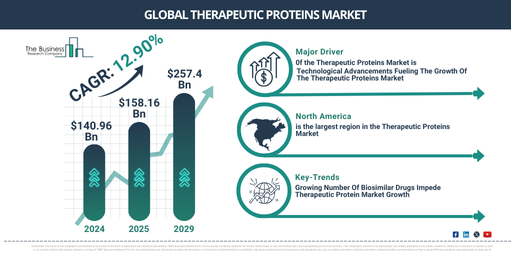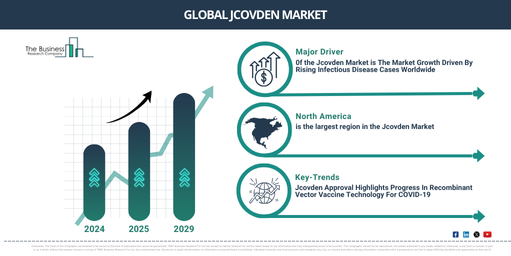Therapeutic ProteinsMarket Overview 2025–2034: CAGR Trends, Long-Term Growth Paths, and Business Implications
Discover trends, market shifts, and competitive outlooks for the therapeutic proteins industry through 2025-2034 with The Business Research Company’s reliable data and in-depth research
How Has The Therapeutic Proteins Market Growth Evolved From 2024 To 2025, And What’s Ahead?
The market size of therapeutic proteins has experienced substantial growth recently, expanding from $140.96 billion in 2024 to $158.16 billion in 2025, with a compound annual growth rate (CAGR) of 12.2%. This impressive growth during the historical period is a result of advancements in protein engineering, broader focus on chronic diseases, the introduction of immunotherapy, the evolution of recombinant DNA technology, and the emergence of targeted cancer therapies.
In the coming years, the market size of therapeutic proteins is anticipated to witness swift expansion. The estimation indicates that it will reach $257.4 billion, with a compound annual growth rate (CAGR) of 12.9% by 2029. Factors contributing to this growth throughout the projected period include regulatory modifications, advanced delivery strategies, incorporation of gene editing, development of biobetters, and the evolution of immunotherapy. Key emerging trends in the forecast period incorporate improvements in the regulatory structure, refined delivery systems, progress in biotechnology, personalized medicine, and the supremacy of monoclonal antibodies.
Download a free sample to assess the report’s scope and structure:
https://www.thebusinessresearchcompany.com/sample.aspx?id=2555&type=smp
What Are the Primary Drivers Supporting the Market Growth of the Therapeutic Proteins Market?
Technological advancements propelling protein-based drug development are driving the therapeutic proteins market. Owing to their inability to be chemically synthesized, therapeutic proteins must be created through genetic engineering and recombinant DNA technology within living cells or organisms. Platforms specializing in protein-engineering such as glycoengineering, pegylation, Fc-fusion, albumin fusion, and albumin drug conjugation assist in augmenting the production yield, purity of the product, circulation half-life, targeting, and functionality of medicinal protein drugs. Belimumab, ipilimumab, taliglucerase alfa, albiglutide, and recombinant human coagulation factor IX represent the range of therapeutic protein drugs that have been concocted using protein engineering technologies and have garnered FDA approval in the previous five years.
Which Primary Segments of the Therapeutic Proteins Market Are Driving Growth and Industry Transformations?
The therapeutic proteins market covered in this report is segmented –
1) By Product Type: Insulin, Fusion Protein, Erythropoietin, Interferon, Human Growth Hormone, Follicle Stimulating Hormone
2) By Function: Enzymatic And Regulatory Activity, Special Targeting Activity, Vaccines, Protein Diagnostics
3) By Application: Metabolic Disorders, Immunologic Disorders, Hematological Disorders, Cancer, Hormonal Disorders, Genetic Disorders, Other Applications
Subsegments:
1) By Insulin: Rapid-Acting Insulin, Short-Acting Insulin, Intermediate-Acting Insulin, Long-Acting Insulin
2) By Fusion Protein: Tnf-Alpha Inhibitors, Anti-Cd20 Fusion Proteins, Other Targeted Fusion Proteins
3) By Erythropoietin: Epoetin Alpha, Darbepoetin Alfa, Other Erythropoietin Variants
4) By Interferon: Interferon Alpha, Interferon Beta, Interferon Gamma
5) By Human Growth Hormone: Somatropin, Somatrem
6) By Follicle Stimulating Hormone: Follitropin Alpha, Follitropin Beta
Request customized data on this market:
https://www.thebusinessresearchcompany.com/customise?id=2555&type=smp
Which Regions Are Key Players in the Growth of the Therapeutic Proteins Market?
The countries covered in the therapeutic proteins market report are Australia, Brazil, China, France, Germany, India, Indonesia, Japan, Russia, South Korea, UK, USA, Canada, Italy, Spain
What Are the Most Significant Market Trends in the Therapeutic Proteins Market?
The therapeutic proteins market growth is expected to decelerate due to the rise in the numbers of biosimilar drugs worldwide. Biosimilars gain market access due to the expiry of patents for therapeutic proteins like monoclonal antibodies. For example, ALYMSY (bevacizumab-maly) was introduced to the market in the United States by Amneal Pharmaceuticals, Inc., a generics and specialty pharmaceutical enterprise based in the US, in October 2022. These affordable alternatives to the original biologics have the potential to decrease the revenue and sales of the therapeutic proteins market.
View the full report here:
https://www.thebusinessresearchcompany.com/report/therapeutic-proteins-global-market-report
What Parameters Are Used to Define the Therapeutic Proteins Market?
Therapeutic proteins refer to pharmaceuticals that are genetically modified versions of human proteins that are found naturally. These powerful, quick-acting medications were developed in a lab for pharmaceutical usage. Therapeutic proteins have altered how diseases are treated since they are very effective in vivo.
Purchase the full report and get a swift delivery:
https://www.thebusinessresearchcompany.com/purchaseoptions.aspx?id=2555
About The Business Research Company:
With over 15000+ reports from 27 industries covering 60+ geographies, The Business Research Company has built a reputation for offering comprehensive, data-rich research and insights. Armed with 1,500,000 datasets, the optimistic contribution of in-depth secondary research, and unique insights from industry leaders, you can get the information you need to stay ahead in the game.
Get in touch with us:
The Business Research Company: https://www.thebusinessresearchcompany.com/
Americas +1 3156230293
Asia +44 2071930708
Europe +44 2071930708
Email us at info@tbrc.info
Follow us on:
LinkedIn: https://in.linkedin.com/company/the-business-research-company
YouTube: https://www.youtube.com/channel/UC24_fI0rV8cR5DxlCpgmyFQ
Global Market Model: https://www.thebusinessresearchcompany.com/global-market-model



